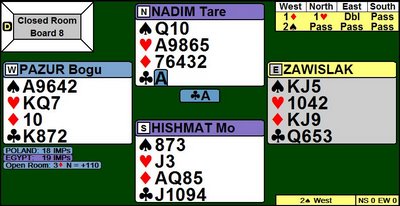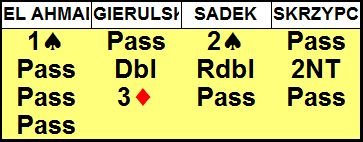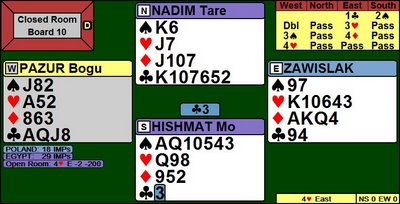Treasure Mine - Systems & Style - Chapter 2 - 4cM - Part I
The recent world championship gives us a treasure trove that can be examined to study systems and style implications for success. For this chapter of the study, 4cM stands for 4 card majors, and our look at the recent world championships will focus on the use of 1st and 2nd seat openings that show 4 card majors. The vast majority of pairs in the open event use 1st and 2nd seat 1H/S openings as promising five card majors, or almost always showing a five card or longer major - sometimes they will put 5(4) on their convention cards to say that a great 4 card suit can open 1H/S, or will have a rare hand type, such as 4-4-1-4 embedded in the 1H or 1S opening, but it is almost always a five card or longer major. A small minority of pairs use a four card major opening of some sort in 1st and 2nd seat.
We will look at these pairs, if they had average or better in the round robin Butler IMP scores - that is the pair, if scored against the rest of the field in the matches they played, did average or better. The pairs we want to look at are (in order they placed in the Butler):
1 Ilan HERBST - Ophir HERBST, Israel - 1H Opening
2 Geir HELGEMO - Tor HELNESS, Norway - 1H Opening
3 Terje AA - Jorgen MOLBERG, Norway - 1H Opening
4 Andreas KIRMSE - Michael GROMOELLER, Germany - 1H Opening
5 David GOLD - Tom TOWNSEND, England - 1H/S Openings
6 Martin REID - Peter NEWELL, New Zealand - Transfer Openings
7 Jason HACKETT - Justin HACKETT, England - 1H/S Openings
8 Slawek ZAWISLAK - Boguslaw PAZUR, Poland - Two-under Transfer Openings
9 Peter GILL - Bobby RICHMAN, Australia - Transfer Openings
* Tom JACOB - Malcolm MAYER - New Zealand - (not included as 4cM only if 15+)
10 Faruk MASIC - Milovan MILOVIC, Bosnia and Herzegovina - Openings showing exact 4
11 Stephen BLACKSTOCK - Stephen HENRY, New Zealand - 1H/S Opening
12 Antonio Victoria LOPES - Vitor DIEGUES, Portugal - 1H/S Openings
For post event review I like using the Swiss federation site, which has the vugraph records in html, txt, and movie formats:
http://www.bridgefederation.ch/2008/wtc/index.html
The Australia-English round 1 match had the North-South pairs exchanging blows with 4 card majors (Gill-Richman with transfer openings). This match and the Norway-Egypt match showed a problem a 4cM approach can give responder:
 .
.
.
.
.
Your partner opens 1H. In one match, your RHO overcalls 1S, in another match your RHO overcalls 2S, what do you bid?
At the table where it was 1H-2S-?, responder for Norway, Helness, bid 3H, landed in a 4-3 fit which made +170 opposite the 3-4-3-3 13 count. In the other match, over 1H-1S-?, Gold for England bid 2H, passed back to RHO who bid 2S - now Gold bid 3D and played there for +110. At the other table, Richman bid 2D over 1S, and when this was raised to 3D, now he supported hearts. Over 3H, opener bid 3S, and Richman bid 5D, down 2.
Note if the pairs played the methods of New Zealand's Jacob-Mayer (4cM only possible if 15+), they could support hearts, knowing if opener had only 4Hs he would make another call since 15+. Likewise one can use methods where 1H is flat and/or just 4Hs if minimum values - now responder can bid 2D, and if opener can just raise to 3D, then responder can pass knowing opener does not have a shapely hand with 5+Hs.
In the Israel-Netherlands match, one of the Herbsts opened 1C, not 1H - they play 1H can be a 4cM, but the only hand where they would have to open 1H and not 1m would be 4-4-3-2 exactly.
Board 6 was a four card major opening at one table of Australia-England, but nothing to report.
In round 2, board 22, Zawislak-Pazur for Poland opened 1D showing 4+Ss, but had science to get to the 5-3 fit. The next hand had a 1C opening with 4+Hs, this time landing in 1NT making, while in the open room their teammates got to a 4-3 heart fit over a weak notrump opening, and made this too for 5 IMPs. The final board of the match saw another 1D opening showing 4+Ss, but instead of the 5-3 spade fit they settled for a 4-4 fit fit in 6C - both 6C and 6S making on the calm layout.
In round 3 Zawislak-Pazur continued: board 2 had a 1C 4+H opening to reach the nice 3NT, another 1C opening on board 4 where they stayed low, and a 1D 4+Ss opening on board 6 that prevented the opponents from playing in a nice spade partial.
Board 8 produced a 7 IMP swing, partly on how the spade fit was found:
.
.
.
.
.
.
.
Here East doubled to show values, and West showed the 5th spade. In the Open Room, the 5-3 spade fit was found immediately, and then North-South competed to their 9 card diamond fit, and East with short diamonds, but only five spades and a minimum left it there:
 .
.
.
.
.
Board 10 showed another slow route to the 5-3 major fit - both tables were down two in 4H.

.
.
.
.
.
.
And day 1 of the World of 4cM was done.
The recent world championship gives us a treasure trove that can be examined to study systems and style implications for success. For this chapter of the study, 4cM stands for 4 card majors, and our look at the recent world championships will focus on the use of 1st and 2nd seat openings that show 4 card majors. The vast majority of pairs in the open event use 1st and 2nd seat 1H/S openings as promising five card majors, or almost always showing a five card or longer major - sometimes they will put 5(4) on their convention cards to say that a great 4 card suit can open 1H/S, or will have a rare hand type, such as 4-4-1-4 embedded in the 1H or 1S opening, but it is almost always a five card or longer major. A small minority of pairs use a four card major opening of some sort in 1st and 2nd seat.
We will look at these pairs, if they had average or better in the round robin Butler IMP scores - that is the pair, if scored against the rest of the field in the matches they played, did average or better. The pairs we want to look at are (in order they placed in the Butler):
1 Ilan HERBST - Ophir HERBST, Israel - 1H Opening
2 Geir HELGEMO - Tor HELNESS, Norway - 1H Opening
3 Terje AA - Jorgen MOLBERG, Norway - 1H Opening
4 Andreas KIRMSE - Michael GROMOELLER, Germany - 1H Opening
5 David GOLD - Tom TOWNSEND, England - 1H/S Openings
6 Martin REID - Peter NEWELL, New Zealand - Transfer Openings
7 Jason HACKETT - Justin HACKETT, England - 1H/S Openings
8 Slawek ZAWISLAK - Boguslaw PAZUR, Poland - Two-under Transfer Openings
9 Peter GILL - Bobby RICHMAN, Australia - Transfer Openings
* Tom JACOB - Malcolm MAYER - New Zealand - (not included as 4cM only if 15+)
10 Faruk MASIC - Milovan MILOVIC, Bosnia and Herzegovina - Openings showing exact 4
11 Stephen BLACKSTOCK - Stephen HENRY, New Zealand - 1H/S Opening
12 Antonio Victoria LOPES - Vitor DIEGUES, Portugal - 1H/S Openings
For post event review I like using the Swiss federation site, which has the vugraph records in html, txt, and movie formats:
http://www.bridgefederation.ch/2008/wtc/index.html
The Australia-English round 1 match had the North-South pairs exchanging blows with 4 card majors (Gill-Richman with transfer openings). This match and the Norway-Egypt match showed a problem a 4cM approach can give responder:
.
.
.
Your partner opens 1H. In one match, your RHO overcalls 1S, in another match your RHO overcalls 2S, what do you bid?
At the table where it was 1H-2S-?, responder for Norway, Helness, bid 3H, landed in a 4-3 fit which made +170 opposite the 3-4-3-3 13 count. In the other match, over 1H-1S-?, Gold for England bid 2H, passed back to RHO who bid 2S - now Gold bid 3D and played there for +110. At the other table, Richman bid 2D over 1S, and when this was raised to 3D, now he supported hearts. Over 3H, opener bid 3S, and Richman bid 5D, down 2.
Note if the pairs played the methods of New Zealand's Jacob-Mayer (4cM only possible if 15+), they could support hearts, knowing if opener had only 4Hs he would make another call since 15+. Likewise one can use methods where 1H is flat and/or just 4Hs if minimum values - now responder can bid 2D, and if opener can just raise to 3D, then responder can pass knowing opener does not have a shapely hand with 5+Hs.
In the Israel-Netherlands match, one of the Herbsts opened 1C, not 1H - they play 1H can be a 4cM, but the only hand where they would have to open 1H and not 1m would be 4-4-3-2 exactly.
Board 6 was a four card major opening at one table of Australia-England, but nothing to report.
In round 2, board 22, Zawislak-Pazur for Poland opened 1D showing 4+Ss, but had science to get to the 5-3 fit. The next hand had a 1C opening with 4+Hs, this time landing in 1NT making, while in the open room their teammates got to a 4-3 heart fit over a weak notrump opening, and made this too for 5 IMPs. The final board of the match saw another 1D opening showing 4+Ss, but instead of the 5-3 spade fit they settled for a 4-4 fit fit in 6C - both 6C and 6S making on the calm layout.
In round 3 Zawislak-Pazur continued: board 2 had a 1C 4+H opening to reach the nice 3NT, another 1C opening on board 4 where they stayed low, and a 1D 4+Ss opening on board 6 that prevented the opponents from playing in a nice spade partial.
Board 8 produced a 7 IMP swing, partly on how the spade fit was found:
.
.
.
.
.
.
.
Here East doubled to show values, and West showed the 5th spade. In the Open Room, the 5-3 spade fit was found immediately, and then North-South competed to their 9 card diamond fit, and East with short diamonds, but only five spades and a minimum left it there:
.
.
.
Board 10 showed another slow route to the 5-3 major fit - both tables were down two in 4H.
.
.
.
.
.
.
And day 1 of the World of 4cM was done.

0 Comments:
Post a Comment
<< Home